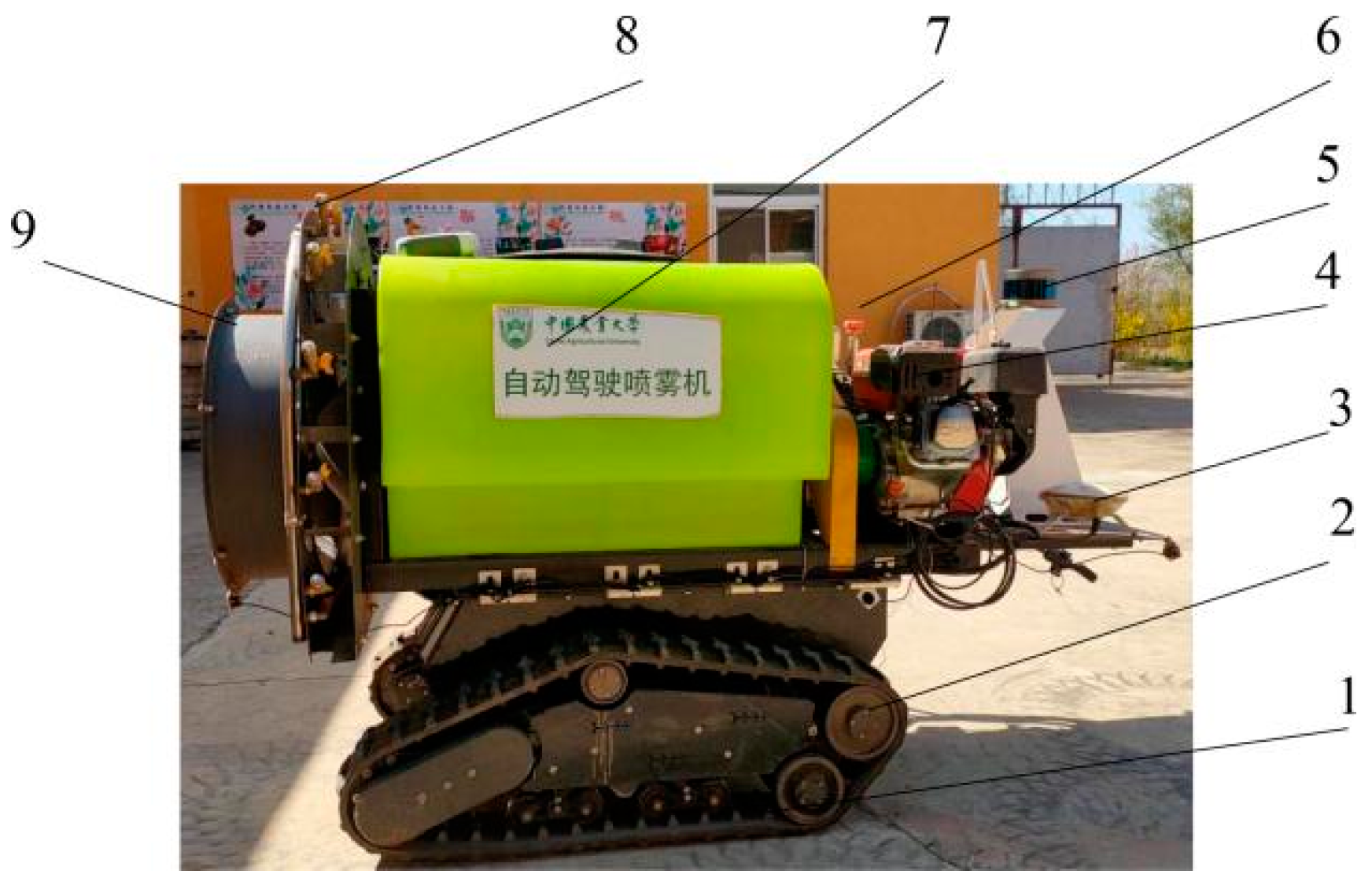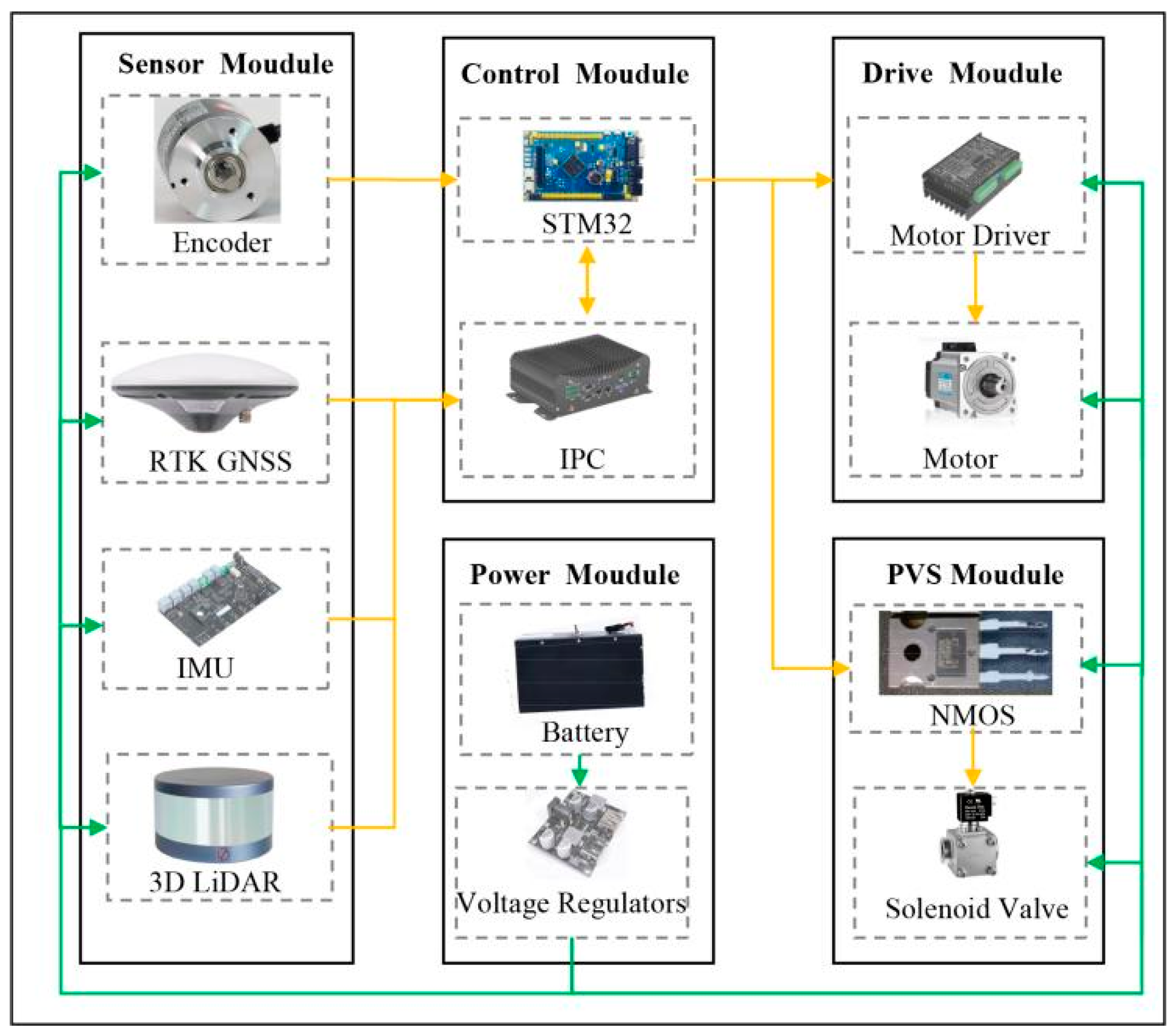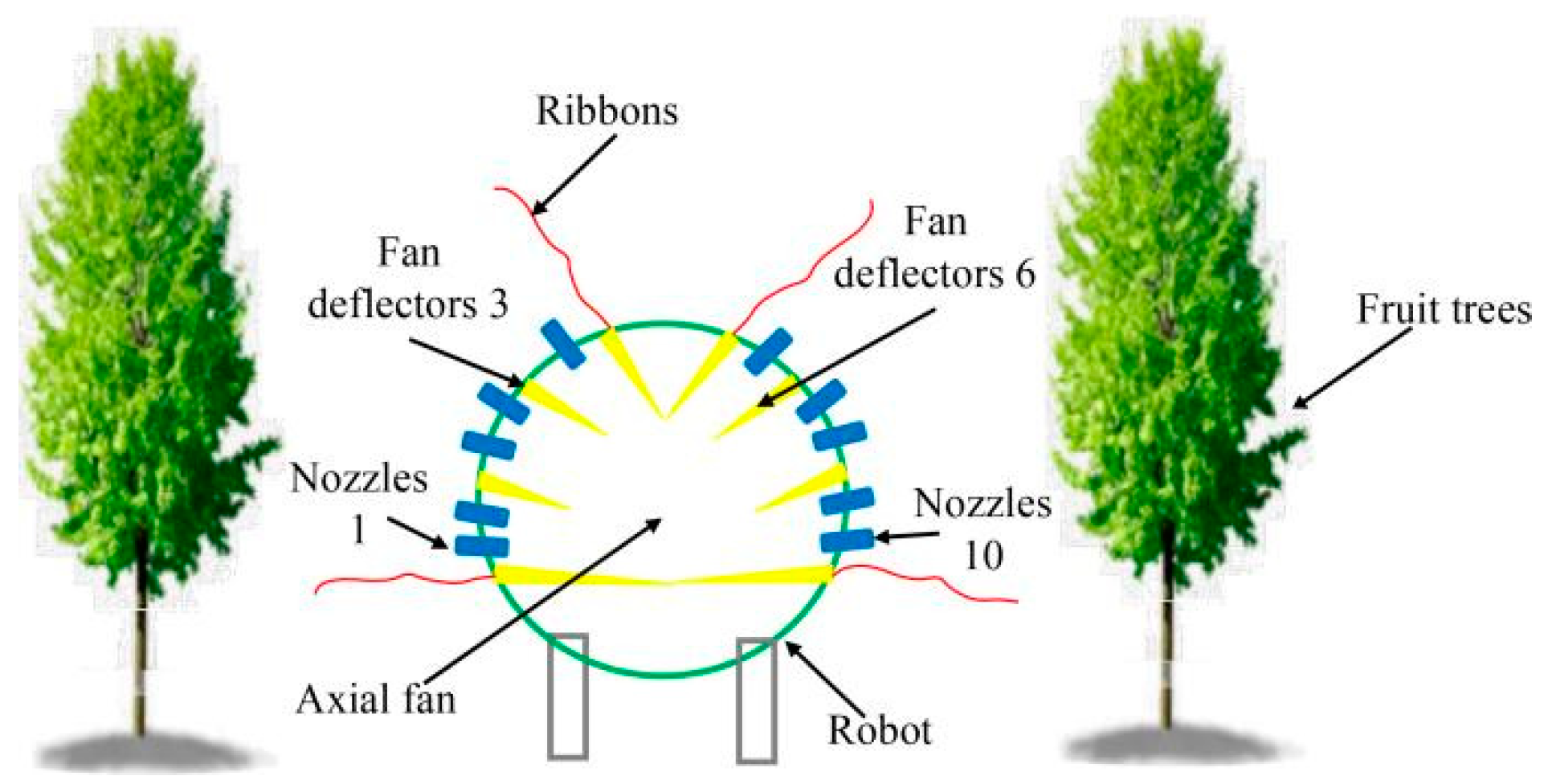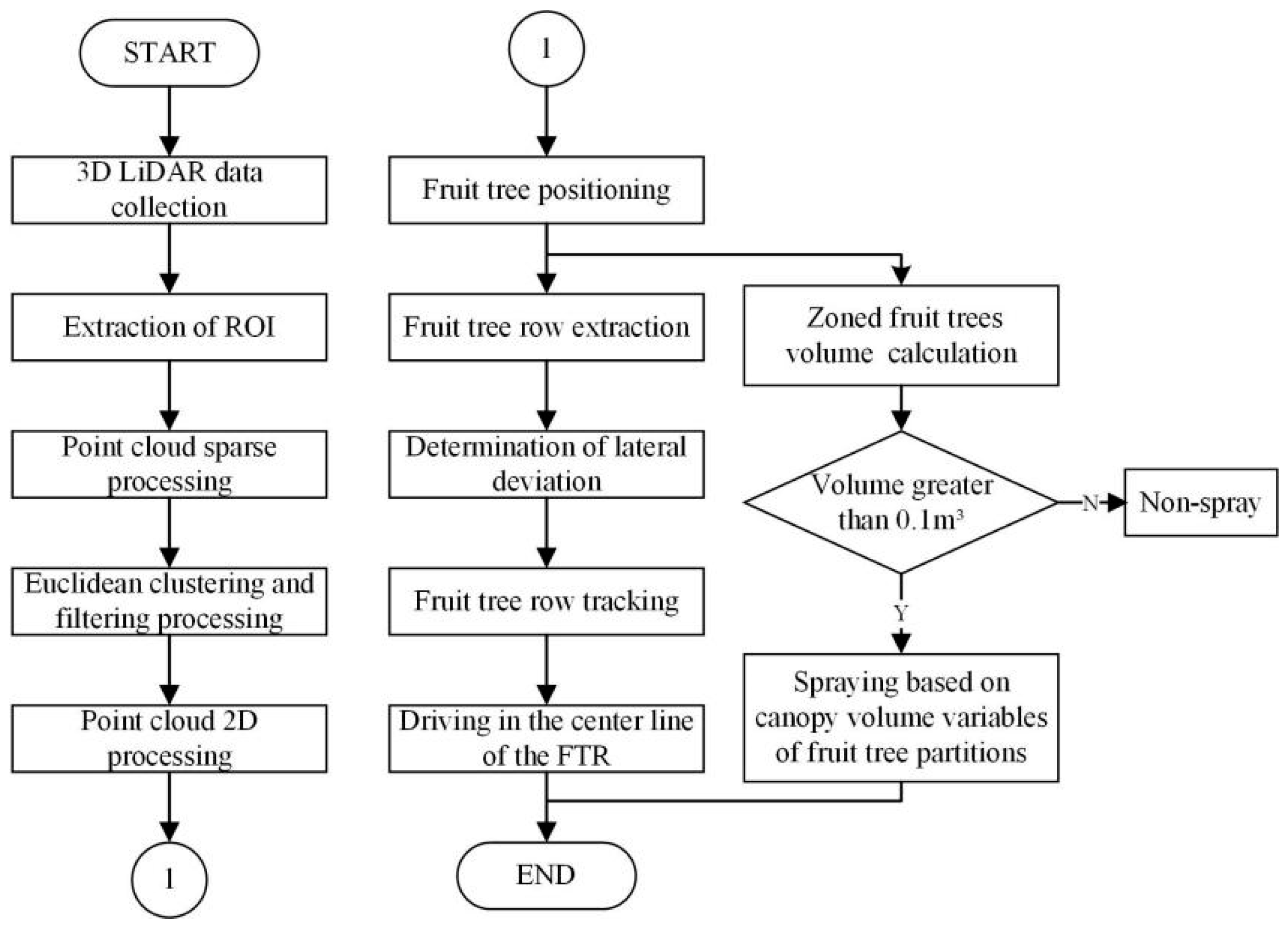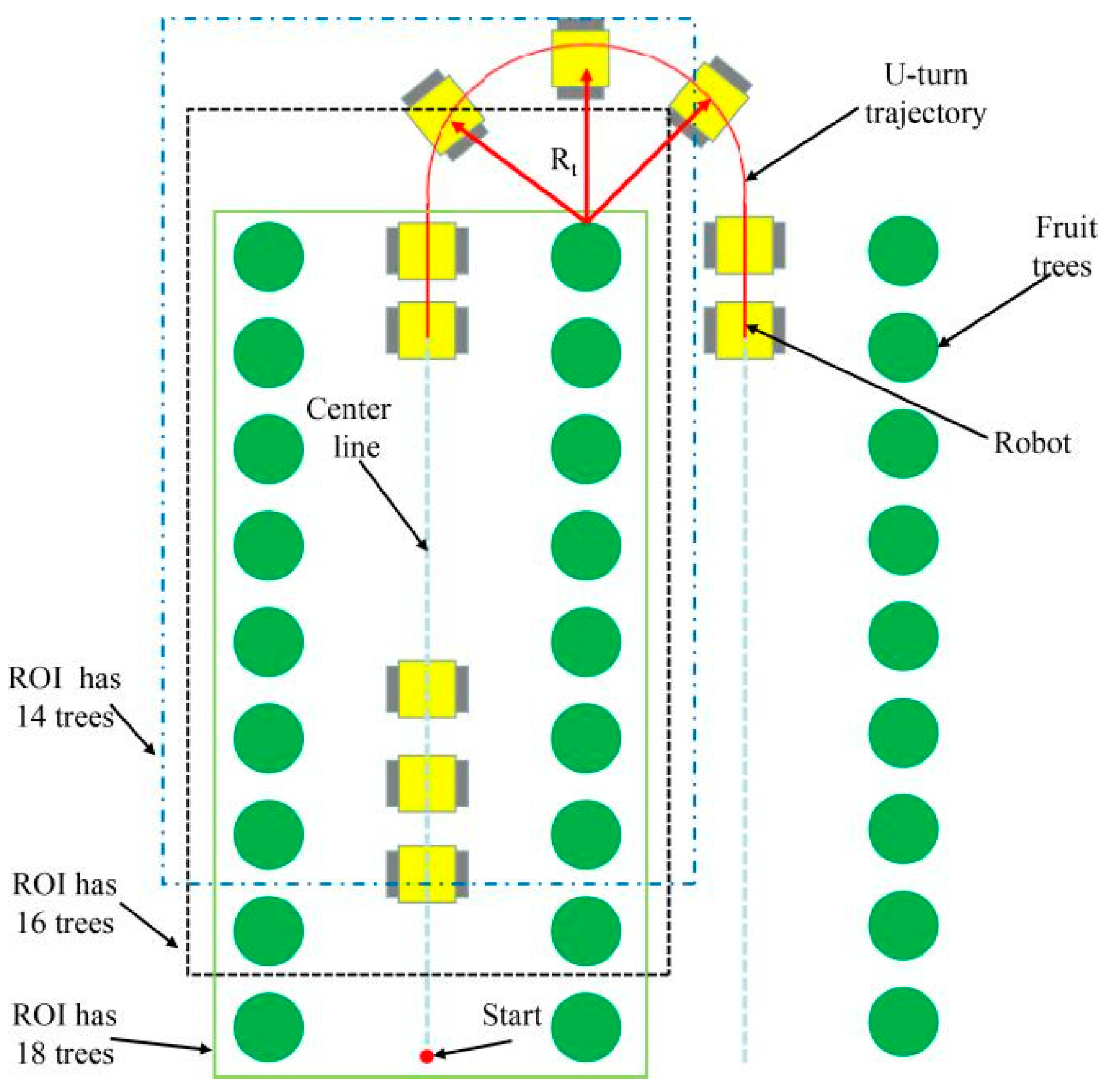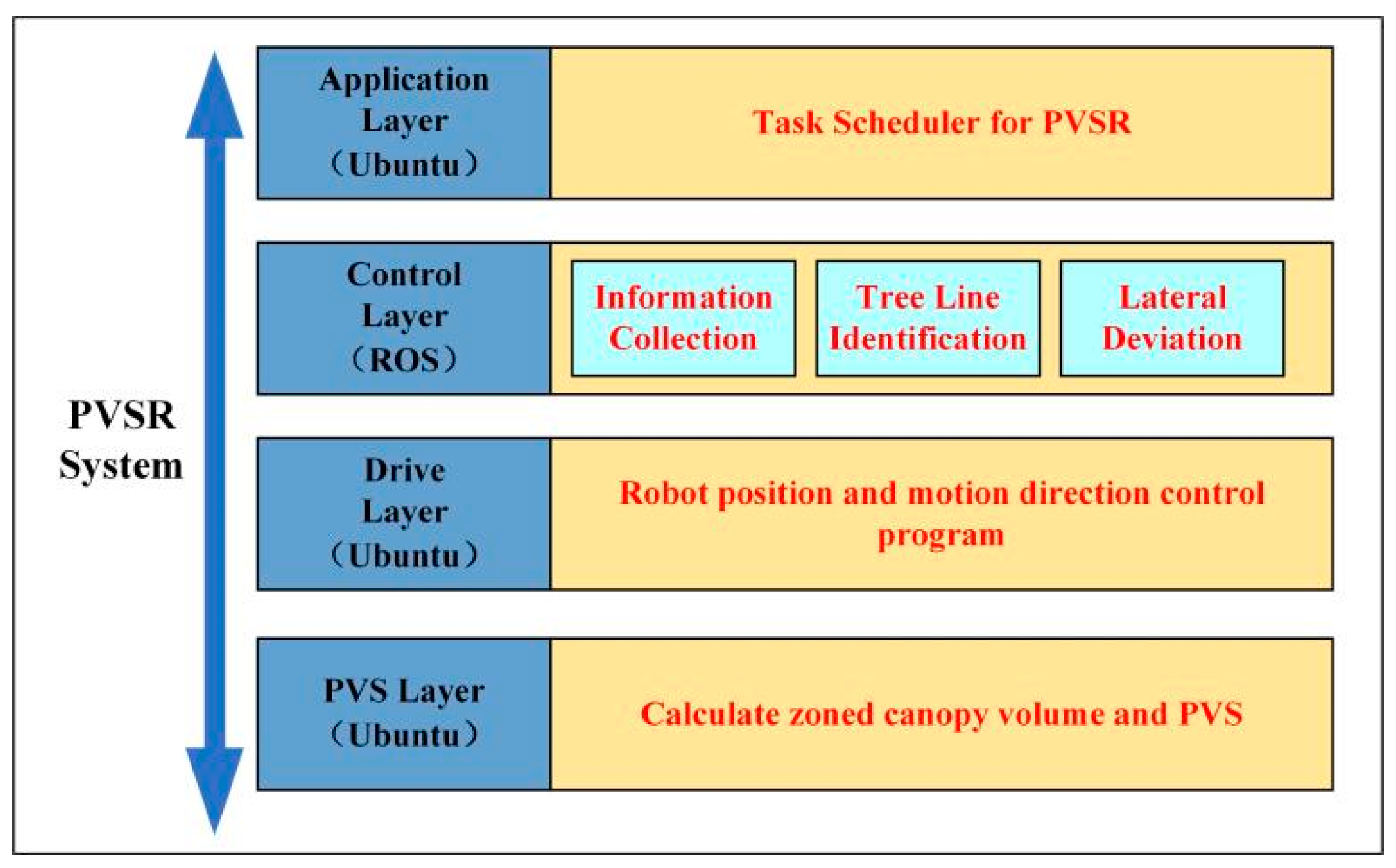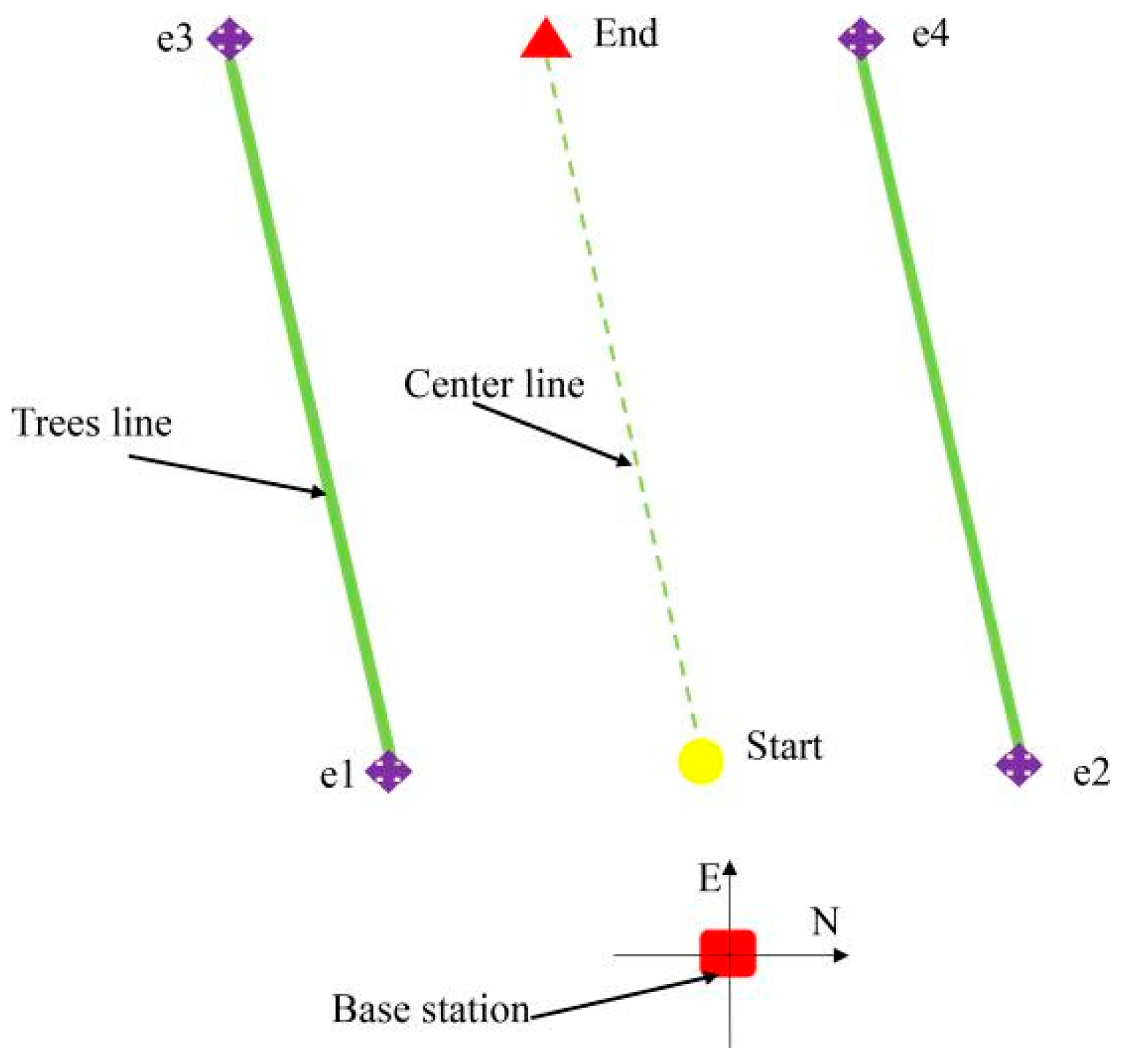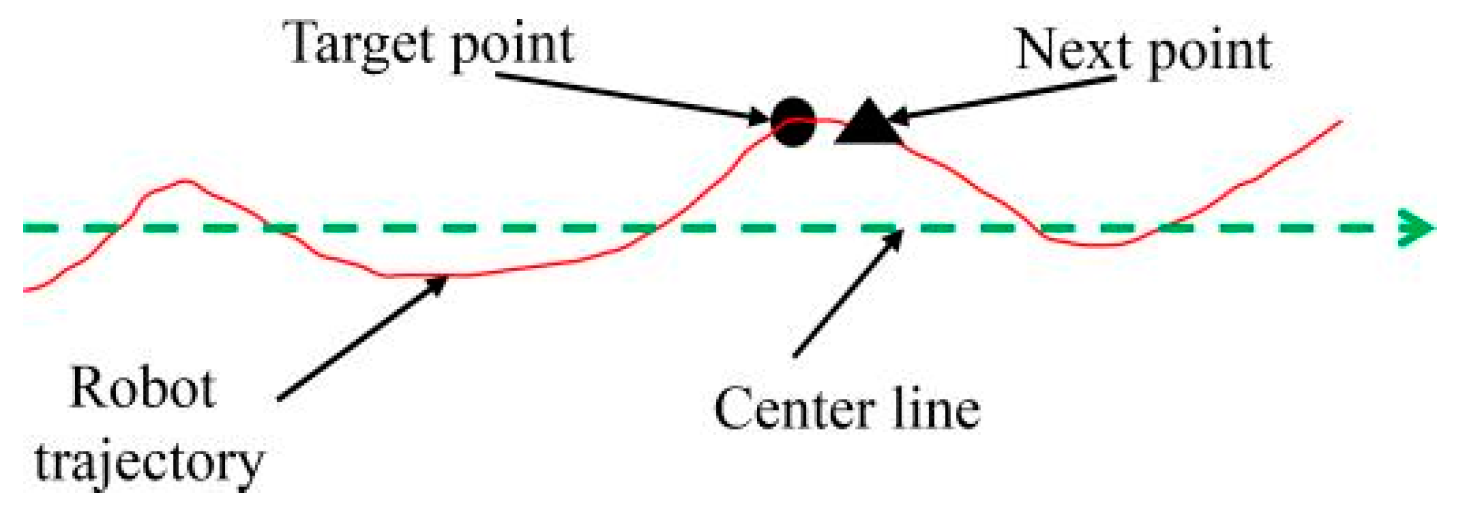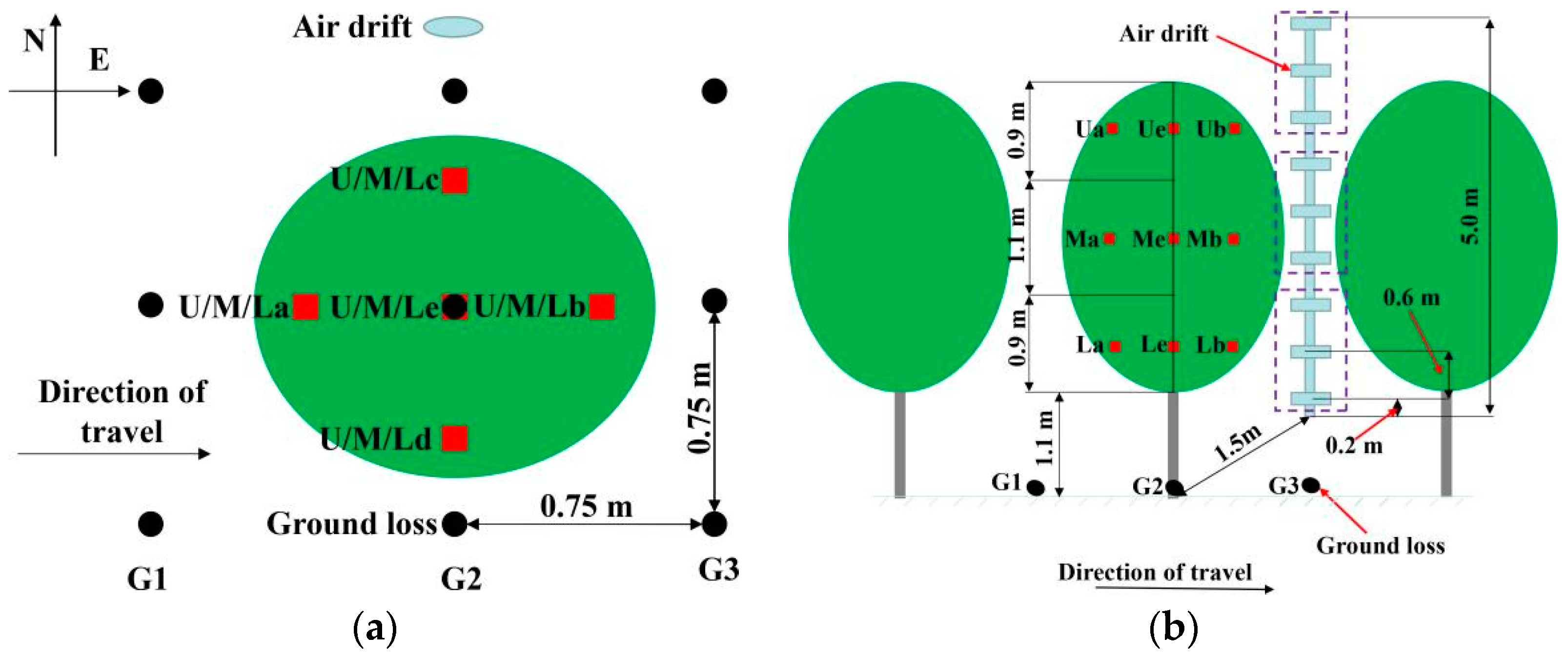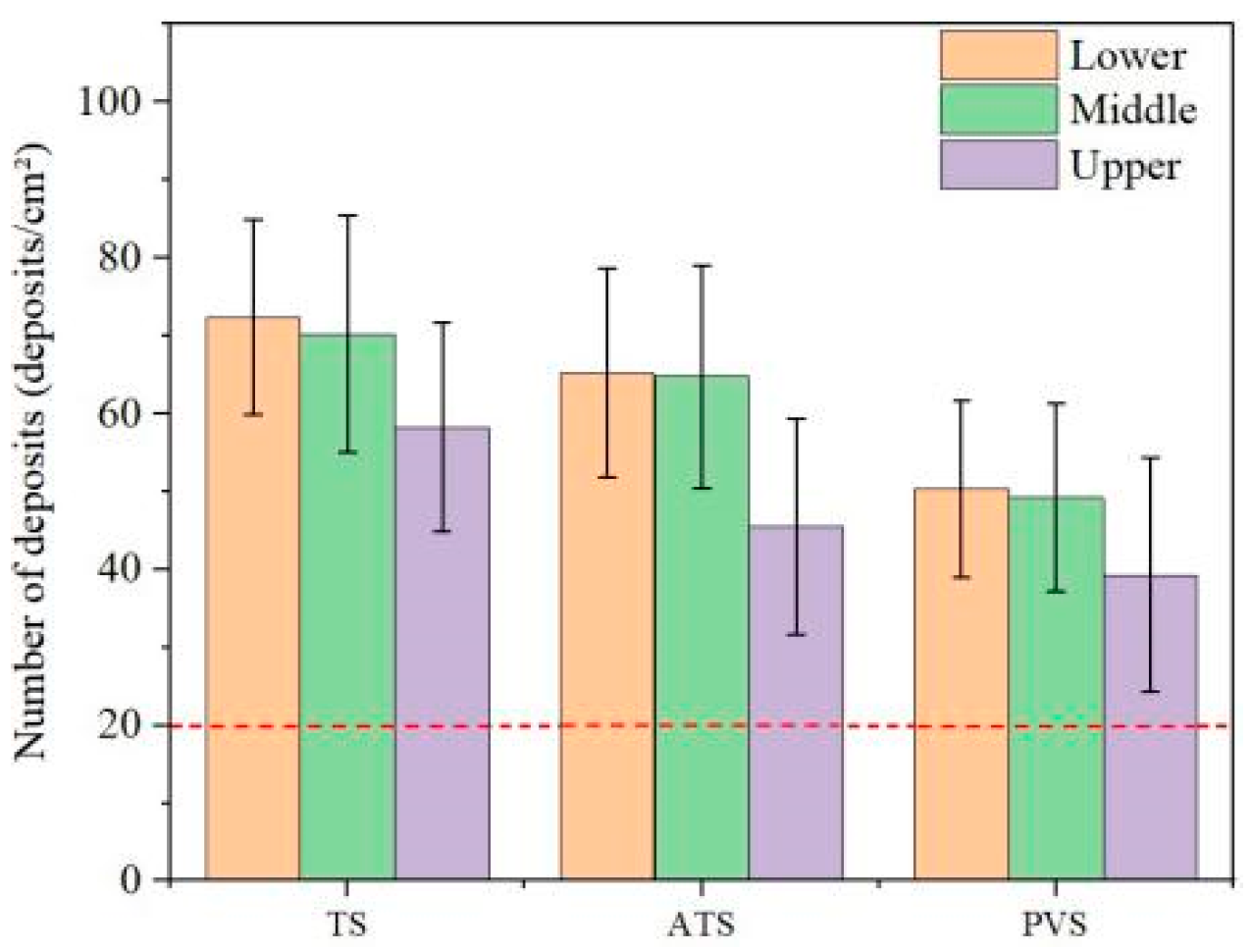1. Introduction
Plant protection in Chinese orchards accounts for about 40% of the total orchard management, with a significant workload of 6–10 applications required during a growth cycle [
1]. TS with fixed parameters are generally used for the orchard plant protection operation, and the application of fixed spraying parameters results in too little pesticide application on some canopies and too much spraying on some canopies [
2]. Chinese plant protection products (PPPs) are mostly driven manually, but more than half of them do not have cabs. Even when they do have cabs, the protection measures are simple and the operators are exposed to the application environment, making the operators easily poisoned [
1,
2].
The remote-controlled PPPs currently produced in China for orchards provide a degree of separation between operators and pesticides. However, the limited range of the remote-controlled PPPs does not completely separate people from the pesticides, and risks remain. It is why the complete separation of human and pesticides on PPPs is a prerequisite for operator safety [
3].
Modern agricultural equipment is being developed in the direction of automation, information technology and intelligence, which will further promote the upgrading and iteration of the agricultural industry [
4]. As the number of people working in Chinese agriculture decreases and the cost of labor increases, smart equipment, including navigation robots, is beginning to be used on a large scale in Chinese agriculture. Compared with other complex agricultural environments, modern orchards are planted in wide rows with narrow plant spacing, and the close connection between branch and leaf plants in a “tree wall” structure provides a simpler navigation environment.
The PPPs with AN function is completely separated from the pesticides, thereby guaranteeing the safety of the personnel during operation and improving the operation efficiency, which will occupy a large market in the PPPs. AN solution based on global navigation satellite systems (GNSS) have been completely applied to field operation environments [
5,
6]. However, Li et al. pointed out that GNSS positioning methods are not suitable for AN operation in orchard scenarios due to the loss of navigation satellite signals caused by the shading of fruit trees [
7].
Current orchards AN operation relies on visual navigation and laser navigation [
8]. Radcliffe et al. collected environmental information from the orchards using a multispectral camera and processed the canopy and sky information to identify the navigation line using a machine learning algorithm [
9] (not specified in the paper, the navigation line refers to the center line of the FTR). Although vision sensors are provided with the advantages of low cost and rich information, the imaging quality is still easily disturbed by light and fails to directly obtain the depth information [
8,
10].
Laser navigation senses the orchard environment in real-time and obtains different fruit tree positions to achieve relative positioning of the robot using LIDAR. LIDAR has the advantages of active luminescence, high-range accuracy, and strong adaptability to the environment for all-weather operation. LIDAR can be classified into single-line 2D LIDAR and multi-line 3D LIDAR [
11,
12,
13]. Based on the Simultaneous Localization and Mapping (SLAM) technology, Santos et al. also developed the GNSS-independent VineSlam localization and mapping method and the vineyard-specific path planner “AgRobPP”, which are proven in mapping and path planning and can perform tasks such as automatic charging [
14]. The SLAM technology based on 3D LIDAR can detect the 3D information of the surrounding environment and enhance the safety of the moving robot [
15]. However, it increases the computational burden and demands higher computational performance. Liu et al. extracted navigation lines and AN operations using 3D LIDAR, but did not obtain the external features (canopy volume and leaf area index (LAI), etc.) of fruit trees [
13]. The above studies achieved AN operations using 2D LIDAR or the 2D processing of 3D LIDAR, discarding the 3D information of the robot’s surroundings.
Vision sensors and LIDAR in AN operation can be used for collecting information on the external features of the canopy of fruit trees in orchards [
2,
16], among which, LIDAR presents unique and excellent performance and is most widely used in orchards PVS [
16,
17,
18,
19,
20]. In this case, it can be used not only for AN, but also for acquiring information of surrounding fruit trees for PVS. However, the use of LIDAR to obtain the LAI of fruit tree canopies requires a large number of point clouds [
21,
22], and the calculation method is too complicated to realize real-time online calculation [
22,
23]. The fruit tree canopy features should be calculated in real time to control the spray volume during PVS operation, but considerable studies have proven the existence of a strong linear relationship between the LAI and the fruit tree canopy volume during the same growth period of fruit trees [
21,
24,
25,
26,
27]. In this case, the LAI can be replaced by the fruit tree canopy volume (FTCV) in the case of a certain growth cycle of fruit trees.
The combination of pulse width modulation (PWM) technology with PVS according to the FTCV has changed the traditional spraying operation with continuous spraying without regard to target differences, achieving the purpose of saving pesticide application, reducing air drift and ground loss, improving the efficiency of spraying operation, which is also endowed with the advantages of low computational intensity and high reliability [
26,
27]. Liu et al. achieved the calculation of canopy volume of fruit trees by a simple sensor array composed of ultrasonic sensors and laser sensors, and the calculation accuracy reached more than 88% [
16], indicating that simple sensors can achieve high accuracy of canopy volume measurement, whereas 3D LIDAR measures more data and fully meets the high accuracy of canopy volume measurement. A vertically mounted LIDAR was adopted by both Li et al. [
28] and Xue et al. [
27] to obtain the external characteristics of fruit trees for PVS and achieve the purpose of saving pesticides and reducing air drift and ground loss. Manned vehicles are used by most of the above PVS devices for application, and are exposed to the risk of pesticide poisoning to the operator increased [
10,
25].
In the above study, the LIDAR was horizontally mounted during AN operation to obtain as much surrounding information as possible, but was mounted vertically to obtain as many fruit tree external features as possible for PVS, failing to enable AN operation [
13]. Compared with the 2D LIDAR, the horizontally mounted 3D LIDAR can detect the 3D information of the surrounding environment. For the above situation, the horizontally mounted 3D LIDAR is used to change the ROI range and calculate the canopy volume of zoned fruit trees, and finally achieve AN and PVS, thus providing a new solution for AN and PVS in orchards. The remaining part of this paper is organized as follows:
Section 2 introduces the electronic hardware system, walking system, spraying system, AN test system and adjustment of the spraying system of the precision variable-rate spraying robot (PVSR);
Section 3 proposes the algorithm to realize the travel along the center line of the FTR, and also the zoned canopy volume calculation and PVS decision based on the point cloud data collected within the ROI;
Section 4 is further designed to verify the performance of AN and PVS, in which the LD and CD of the PVSR are tested by RTK GNSS at normal spraying speed, whereas the volume of droplet deposit (DD), ground loss and air drift of the orchard sprayer are tested by the internationally established DD and air drift standards. A comparison is correspondingly made with TS, automatic targeting spraying (ATS) and PVS;
Section 5 presents the analysis and discussion of the test results;
Section 6 offers the conclusion.
3. Implementation Principles and Software Design
A reasonable workflow should be designed, and related programs should be written to realize the functions of the PVSR, as shown in the flow chart of
Figure 4. The specific display process will be expanded and described as follows.
3.1. Construction of the Robot Motion Kinematic Model
The world coordinate system (WCS) is constructed by taking the center line of FTR at the starting position as the origin and the center line of FTR as the
X-axis. The forward direction of the PVSR is the
X-positive direction, whereas the left side of the PVSR is the
Y-positive direction. As shown in
Figure 5, the body coordinate system (BCS) is constructed with the center point (
OR) of the PVSR as the origin of the BCS. Considering the adoption of differential steering of the left and right wheels, the instantaneous velocity (
, m/s) and angular velocity (
, rad/s) of the PVSR as a whole at that instant can be obtained from the velocity of the left wheel (
, m/s), that of the right wheel (
, m/s), and the distance between the two wheels (2
,
= 0.5 m), as shown in Equation (1).
where
is the time of one frame of LIDAR data, i.e., 0.1 s here.
The Cartesian coordinates (
,
) and yaw angle (
, °) of the PVSR in the WCS at the next time (
) are obtained according to the kinematic model as shown in Equation (2).
3.2. ROI Extraction
The LIDAR is installed at a height of 1.2 m. LIDAR with a maximum range radius of 150 m can theoretically sense a circular orchard with an area of 70,685.83 m
2. The complete function of the PVSR can be achieved by the point cloud information within a certain range of the body. However, too much information not only causes data redundancy, but also affects the instantaneity of the system, and the redundant information is cropped to extract the appropriate ROI. As shown in
Figure 6a, the schematic diagram of LIDAR detects the canopy range of fruit trees in the nearest FTR, where the red dotted line describes the LIDAR boundary laser beam, the yellow solid line is realized as the vertical distance from LIDAR to the FTR line (half of the FTR distance), and the blue dashed line represents the linear distance of a fruit tree from the LIDAR. The LIDAR close to fruit trees can only detect a portion of the canopy, whereas that farther away can detect the entire fruit tree canopy, as shown in
Figure 6b. ROI is not only used for AN, but also for obtaining the complete canopy information of fruit trees, as well as the triangle formed by the blue dashed line, laser beam and fruit trees in
Figure 6a. It is known that the
th fruit tree in front of which the PVSR is advancing satisfies the conditions of Equation (3).
where
represents the taken integer function at positive infinity;
the row spacing, m;
the height of the fruit tree, m;
the LIDAR installation height, m; and
the plant spacing, m. Bringing in the information of the test orchard in
Section 4.1,
can be obtained as 7.
In order to ensure that no rows of fruit trees are missed and that the complete information of the fruit trees at the end of the ROI can be detected, the x range of the ROI in the BCS is set as [−3.0 m, +10.5 m] (there are 18 fruit trees in the ROI, including 14 in front of the LIDAR and 4 behind it), y ranges [−2.5 m, +2.5 m], and z is [−1.9 m, 4.8 m].The final range of ROI is obtained by cropping the x, y, and z dimensions using the pass-through filter in the PCL (under the terms of the BSD license). The pass-through filter is simple and effective, which can also traverse each point in the point cloud in the specified dimension, determine whether the point takes values in the specified dimension in the value domain, and delete the points beyond the range. The ROI is updated every 0.1 s during AN.
3.3. Fruit Tree Positioning
Changing the Voxel size to 0.05 m × 0.05 m × 0.05 m by using the PCL’s Voxel Down-Sampling function further reduces the number of point cloud and improves the computational rate. Moreover, the processed point cloud results are stored, and the WCS of the robot in the ROI region is stored in the same memory for fast computation.
The Statistical Filter of PCL is used to remove noise outliers, and the Euclidean clustering algorithm of PCL is used to cluster the point clouds to obtain the point cloud data Pki, with a minimum distance threshold of h/3, a minimum number of 10 clustering points, and a maximum number of 5500. Upon the completion of the clustering, the 3D point cloud is projected to the XOY plane in WCS for 2D processing, and the projected center (Xi, Yi, 0) of the tree is calculated using PCL as the position of the fruit tree in WCS.
3.4. Fruit Trees Line Acquisition and PVSR Motion
The point cloud data
Pki are divided into positive and negative directions of the
Y-axis with the WCS
X-axis as the center, using the RANSAC algorithm to fit the point clouds of the fruit trees on both sides to obtain the fruit trees lines on the left and right sides of the PVSR, as shown in Equation (4).
where
, and
represent the left and right FTR lines of the robot, respectively, whereas
,
,
, and
are constants.
The PVSR needs to travel along the center line of the FTR, i.e., the
X-axis of the WCS, whereas the robot travels toward the center line at the furthest point from the ROI; at the next moment, the lateral movement distance of the robot (
) is shown in Equation (5).
where
refers to the difference between the middle of the farthest FTR in the ROI and the robot on the WCS
X axis (10.5 m × the robot yaw angle provided by IMU), and
represents the distance that the machine needs to move to the lateral direction.
The movement of the PVSR in WCS is shown in
Figure 7. The displacement is represented by the red line
O1O2 (length
), and the actual trajectory, the black arc
O1O2 from point
O1 to point
O2. In this case, based on the geometric relationship, the overall velocity
and angular velocity
of the PVSR can be obtained by Equation (6).
The value of displacement
is further expressed by the
:
where
refers to the scale factor, and
a is the initial forward-looking distance, m.
3.5. Autonomous Turning
As shown in
Figure 8, the number of fruit trees in the ROI decreases when the robot is about to enter the end of the FTR. The end-of-row judgment mechanism is hereby designed to prevent any misjudgment. Less than 18 fruit trees are identified in the ROI, and the judgment mechanism is exited in the case of an odd number of fruit trees, which continues to judge the number of fruit trees in the next ROI when the number of fruit trees in the new ROI is less than 16. When the number of fruit trees in the new ROI is fewer than 16, it means that the robot is about to enter the end of the FTR and reduce the range of the positive direction of the
x-axis of the ROI at BCS according to Equation (8).
where
denotes the value taken in the positive direction of ROI, m, and
represents the number of times the robot updates ROI.
When there are only two trees in front of the LIDAR in the ROI, a U-turn will be planned, as shown by the red U-shaped line in
Figure 8. The radius of the turn is
(half the distance of the FTR), and the angular velocity
of the turn is shown in Equation (9).
When the IMU detects a yaw angle of the body greater than 165°, the ROI range is restored, and the turn is successful when the number of fruit trees detected within the ROI is greater than 4. Afterward, the heading is adjusted to continue along the center line of the next FTR. If no fruit trees or other conditions are detected, the operation will be stopped and an abnormal warning will be issued.
3.6. Implementation of PVS
3.6.1. Calculation of Zoned Canopy Volume
The determination of the fruit tree zoned canopy volume is the key to achieving PVS. The point cloud set
Pki within the ROI is cropped to obtain the information about the FTC located in front of the LIDAR. To obtain more FTCV information, the navigation ROIs are combined into one volume ROI when the PVSR drives from the current fruit tree to the next fruit tree, i.e., 12 navigation ROIs constitute one volume ROI. The volume ROI that can completely detect the whole FTC is taken as the target ROI, and only part of the FTC can be detected if the ROI is continuously updated.
Figure 9a is a schematic diagram depicting the obtaining of the target fruit tree volume. Moreover, the FTC has 7 partitions, and the 7 fruit tree partitions are divided into 13 volume calculation domains, as shown in
Figure 9b. All other partitions of fruit trees except the first partition are divided into upper and lower parts, and the dividing point is the intersection of the outermost laser line of ROI and the right side of the FTC, making a horizontal line parallel to the line of FTR as the dividing line. Upon the completion of canopy partitioning, the point cloud of one side of the fruit tree is projected onto the XOZ surface, and the number of point clouds in the 0.1 m × 0.1 m grid is counted. If there is a point cloud, the absolute value of the trunk center of mass Y value in WCS and the minimum value of the absolute value of the point cloud Y value are calculated as the difference, which is further multiplied with the grid area to obtain the volume value. Meanwhile, the volume value of the region is discarded if the grid exceeds half of the demarcation line and the ROI boundary line. As shown in
Figure 9b, the volume value of the upper canopy, the middle canopy, and the lower canopy is V
T + V
1U, V
1L + V
2U + V
2L + … + V
4U, and V
4L + V
4U… + V
6L, respectively.
3.6.2. PVS Decision Making
After obtaining the volume of the FTC, the PWM duty cycle of the corresponding solenoid valve is controlled, and the relationship equation between the nozzle flow rate
(L/min) and the duty cycle
(%) is calculated as:
The relationship between nozzle spraying volume and the different canopies volume of a tree was determined by the fixed amount of spraying per unit volume, which 0.1 L of pesticide application was sprayed in 1 m
3 of a canopy volume [
18]. Therefore, the relationship between the solenoid valve duty cycle
and the zoned canopy volume of a tree can be expressed as:
where
is 0.1 L/m
3;
, different zoned canopy parameters, 1.0 for the lower, 1.1 for the middle and 1.3 for the upper;
is the number of nozzles corresponding to the FTC.
3.7. Software System Design
In order to improve the development efficiency and reduce the workload of repeated development of the software system, this software system is mainly developed based on the popular Robot Operating System (ROS, Stanford Artificial Intelligence Lab, San Mateo, CA, USA). C/C++ was used as the main development language to develop the information collection and processing package, the FTR identification function package, the LD determination package, the motion control function package, the zoned canopy volume calculation package, and the PVS decision package based on ROS Melodic and Ubuntu 18.04 (Canonical Inc. London, England), as shown in
Figure 10. Most attention should be paid to the control layer and the PVS layer.
4. Test Scheme Design and Data Analyses
The test was conducted on 11 October 2021 under sunny weather, with temperatures ranging from 17.2 °C to 18.5 °C and wind speeds ranging from 0.8 m/s to 1.3 m/s. The AN and spraying performance verification test was carried out in a modernized Fojianxi pear plantation in Xiying Village, Yukou Town, Pinggu District, Beijing (40.1962° N, 116.9902° E), with 5-year-old fruit trees. The average tree height was 4.0 m, the trunk height was 1.1 m, and the plant spacing was 1.5 m. As shown in
Figure 11, the navigation test area was 50 m long and 4 m wide, whereas the spraying test area was 50 m long and 8 m wide, 10.5 m from the headland of the orchard. A location with a good satellite signal was selected as the navigation test area. The weather station was placed 10 m away from the base station to collect the weather information during the test. As shown in
Figure 11, the black dashed line refers to the driving trajectory of the machine during the AN test, and the red solid line represents the driving trajectory during the spraying operation.
4.1. Test Design for the AN Performance
The base station was placed in an open area 15.5 m away from the test area as shown in
Figure 12, and the NCS was constructed with the base station as the origin, the north–south direction as the
x-axis and the east–west direction as the
y-axis. The fully loaded PVSR was transported to the middle of the rows of fruit trees at the headland of the orchard before the test. The RTK mobile station was used to measure the coordinates of the fruit trees at the beginning of the row (e1 (
,
), e2 (
,
)) and the end of the row (e3 (
,
), e4 (
,
)) in the BCS on both sides of the navigation test area, from which the coordinates of the startpoint and the endpoint coordinates were ((
+
)/2, (
+
)/2), and ((
+
)/2, (
+
)/2), respectively. The equation of the center line in the NCS can be obtained as:
Equation (12) can be simplified as:
where
,
, and
are all constants.
During the test, the power supply was started, the gasoline engine and the system program were driven into the test area at a speed of 1.25 m/s along the black arrow in
Figure 11, and the real-time position of the PVSR in the NCS was obtained by the RTK mobile station.
The vertical distance from the trajectory point (
,
) to the center line at different moments is the LD of the robot when it navigates autonomously. The LD (
, cm) in the NCS can be obtained as:
As shown in
Figure 13, the CD of the target point, which can be used as the angle between the center line and the line formed by the target point and the next point, requires the slope
(as −B/A) of the center line under the NCS, also the slope
(as (
y0n −
y0)/(
x0n −
x0)) of the line formed by the target point (
x0,
y0) and the next point (
x0n,
y0n) on the robot trajectory.
The CD
can be calculated as:
The LD is positive when the robot trajectory is to the left of the center line, and the CD is positive when the course angle deviates to the left of the center line.
4.2. Spraying Comparison Test
In order to verify the spraying performance of the PVSR, three fruit trees in the test area were selected as plants for the spraying performance test, as shown in
Figure 11. The FTC was divided into the upper, middle and lower canopy, and five pieces of 8.5 cm × 5.4 cm polyvinyl chloride card (fixed with double-ended clamp, Taoka Inc., Jingmen, Hubei, China) were arranged in each canopy according to the east, west, north, south, and middle canopy and the DD were collected according to the reference [
18] and the international Standard ISO 22522 [
30], as shown in
Figure 14. Nine pieces of 7 cm diameter filter paper (each 0.75 m apart) were arranged at the bottom (G2), left (G1) and right (G3) sides of the test tree to collect the ground loss of DD during the application. The test site is shown in
Figure 15. Compared with water-sensitive paper, polyvinyl chloride card has a smaller droplet diffusion coefficient, making it easier to obtain the number of droplets. The filter paper has a larger droplet diffusion coefficient, which is suitable for obtaining the volume of droplet deposit.
According to the reference [
18,
31,
32] and the international Standard ISO/FDIS 22866 (the standard was modified according to the actual situation) [
33], a 5 m high vertical upright pole was arranged at 1.5 m from the test fruit tree trunk. A distance of 1.5 m is the maximum width of the FTC. As shown in
Figure 14, the wind speed and direction requirements are labeled [
31,
32]. At a height of 0.2 m, 0.8 m, and 1.4–5.0 m from the ground, a total of 9 rectangular metal nets of 400 mesh (7.5 cm × 2.5 cm) were vertically fixed using a double-ended clamp to collect the air drift during the spraying process, and each group of three divided the nine nets into the top, middle and bottom layers. The maximum height of the sample (5.0 m) was required to be higher than the height of the fruit tree canopy (4.0 m) [
31,
32].
A 3.0 g/L solution of Tartrazine was used as the test tracer, and the original solution was taken from the tank and stored in a tube before the test. The comparison test for the PVS, the ATS, and TS was conducted using the same machine, and the difference was that ATS determined whether to spray based on the presence or absence of FTCV, whereas TS continuously spraying regardless of canopy or gap between fruit trees (GBFT). Each spraying test traveled 100 m and collected the metal mesh into a valve bag (17 cm × 12 cm) before the PVSR made a turn. When the test was completed, all samples were placed into the valve bag for storage, and the spray pressure was 5 bars.
The DDs in this study were yellow, whereas the filter paper was white. Therefore, the DD samples within the canopy were scanned using an EPSON DS-1610 scanner (Epson, Nagano, Japan) with a resolution of 600 dots per inch (dpi), and the number of DDs per unit area was obtained using DepositsScan programmed in ImageJ free software V1.38x (National Institutes of Health, Bethesda, MD, USA) [
34]. After scanning, the valve bag was eluted with deionized water as the eluent, and the valve bag was sealed by adding 50 mL of deionized water inside the bags. Then, the samples were shaken with an NMY-100A horizontal shaker to fully dissolve the DD on the samples, and the solution in the valve bag was collected into a cuvette using a 100 μL pipette, and placed into a UV-V spectrophotometer (Jingke Inc., Shanghai, China) of 722s type. The absorbance of Tartrazine eluate was measured using a visible spectrophotometer at a wavelength of 426 nm, and the DD volume vs. of the sample was obtained using the method proposed by Li et al. [
28], whereas the volume of DDs per unit area was obtained based on the area of the filter paper. Given that the same solution in the same tank was used by these three spraying types (ST) but the spraying volume was different, the deposit volume in the canopy was normalized using the method proposed by Gil et al. [
35] to compare the advantages and disadvantages of the two application technologies, as shown in Equation (16).
where
dg refers to the normalized unit area DD volume, μL/cm
2;
Vs, the sample DD volume, μL;
Vz, the pesticide application volume, L/hm
2; and
S, the sample area, cm
2.
4.3. Data Analyses
The collected data were analyzed using SPSS Statistics Version 20(IBM Inc., Armonk, NY, USA) for Windows, and plotted using OriginPro Version 2020 (OriginLab Inc., Northampton, MA, USA). All the test results were tested for normal distribution using SPSS and conformed to normal distribution.
One-way analysis of variance (ANOVA) with SPSS was used to analyze the variance of pesticide application with Duncan’s post hoc test, and a two-way multivariate ANOVA with SPSS was used to conduct ANOVA and Duncan’s post hoc test for DDs, ground loss and air drift. The effect of ST and sample location (SL) on DDs, ground loss, and droplet drift was determined using two-way ANOVA with a significance level of 0.05. In all cases, the means of DDs, ground loss and air drift at different SL were compared at the 0.05 significance level using Duncan’s post hoc test.
6. Conclusions
A single 3D LIDAR, encoder and IMU were hereby used to realize the AN and PVS of the PVSR. The test results show that the robot fully meets the requirements of autonomous plant protection operation in orchards. In the AN process, the vertical distance from the robot’s trajectory to the center line, i.e., the LD, does not exceed 22 cm, whereas the angle between the trajectory and the center line, i.e., the CD, does not exceed 4.02°. As far as pesticide application was concerned, there was an extremely significant effect of ST (p < 0.001), and pesticide application was greater in TS than ATS and PVS. Compared with TS, ATS and PVS saved 20.06% and 32.46% of pesticide application, respectively. Although PVS reduces the pesticide application, its inner side canopy has number of DD greater than 20 deposits/cm2. This fully meets the pest and plant disease control requirements for orchards set by the international Standard ISO 22522.3. ST, SL and their interaction had significant effects (p < 0.05) on DD and droplet penetration rate. After DD was normalized, the interaction effect had no significant effect on DD of outer side canopy and mean, but an extremely significant effect on DD of inner side canopy (p < 0.001). After DD normalized, PVS had the best spraying efficiency with a 16.8% increase over TS. As far as pesticide loss was concerned, ST, SL and their interaction had significant effects (p < 0.05) on pesticide loss volume. On the other hand, ST had no significant effects (p = 1.00 > 0.05) on the distribution proportional case of pesticide loss. Additionally, SL and its interactions had extremely significant effects (p < 0.001) on the distribution proportional case of pesticide loss. As far as the distribution proportional case of pesticide loss was concerned, PVS and ATS are different from TS. In terms of ground loss, TS accounted for the largest amount at the bottom of the fruit trees (G2) and the same amount on both sides of the trees (G1 and G3). This is the opposite of ATS and PVS, which is caused by TS-ineffective spraying. In terms of air drift, again, the difference with ATS and PVS was also caused by TS-ineffective spraying.
Reducing pesticide application and pesticide losses while ensuring spraying effectiveness and operator safety remains our research goal. From our research, we found that reducing ineffective spraying is an important tool to improve spraying efficiency. Additionally, making appropriate spraying decisions for fruit tree canopy characteristics is a way to further improve spraying efficiency.
